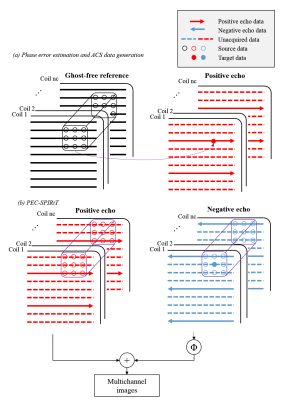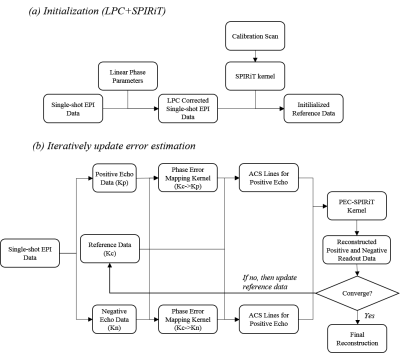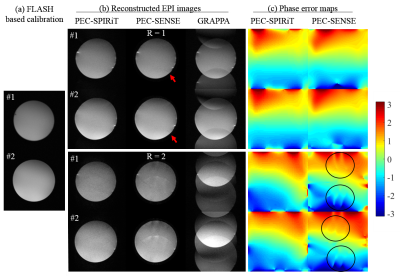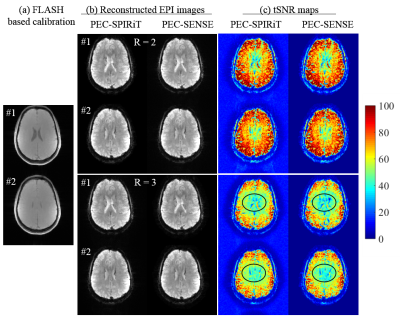4214
EPI Nyquist ghost removal by incorporating iterative k-space based phase error estimation and correction with SPIRiT (PEC-SPIRiT)1Laboratory of Biomedical Imaging and Signal Processing, The University of Hong Kong, Hong Kong, China, 2Electrical and Electronic Engineering, The University of Hong Kong, Hong Kong, China, 3Toshiba Medical Systems (China), Beijing, China
Synopsis
EPI acquisition suffers from Nyquist ghost due to inconsistency between opposite readout directions. As proposed in our previous work, such inconsistency induced phase error can be removed by incorporating the Phase Error Correction with SENSE (PEC-SENSE). In this study, we employ a k-space based phase error estimation, and remove the EPI Nyquist ghost by incorporating phase error correction with SPIRiT (PEC-SPIRiT). Here, a FLASH scan is used for calibration. The proposed method was evaluated using both phantom and in vivo studies, demonstrating its robustness against distortion mismatch and at high accelerations.
Introduction
EPI acquisition suffers from Nyquist ghost due to inconsistency between opposite readout directions. As proposed in our previous work, such inconsistency induced phase error can be removed by incorporating the Phase Error Correction with SENSE (PEC-SENSE) [1, 2]. However, PEC-SENSE relies on pixel-wise operation in image space, which is sensitive to distortion mismatch between calibration scan and EPI scans, using a Fast Low Angle SHot (FLASH) based calibration scan may lead to edge artifacts in final reconstructed images. Moreover, it is prone to localized pitfalls in phase error estimation when reaching higher acceleration factor. In this study, we propose to use k-space based phase error estimation, and remove the Nyquist ghost by incorporating the phase error correction with SPIRiT (PEC-SPIRiT) reconstruction [3], the phase error estimation can be updated iteratively, leading to gradually improved reconstruction. The effectiveness of the proposed approach is demonstrated with FLASH based calibration scan using both phantom and in vivo studies.Method
K-space based phase error estimation and correction with SPIRiT (PEC-SPIRiT)
In this study, a FLASH based calibration scan is used, and the phase error is iteratively estimated from EPI data itself. Assuming that we have “ghost-free” reference data with matched image contrast, we can map the phase error between reference and positive/negative-echo data using a SPIRiT-like kernel (Fig. 1a), termed as phase error mapping (PEM) kernel. With PEM kernel, Auto-Calibration Signal (ACS) data can be synthesized by traversing the central k-space of the reference data. Subsequently, PEC-SPIRiT kernel that builds the relationship between positive/negative echo is trained, and used for reconstruction. In our implementation, the reference is initialized with LPC+SPIRiT reconstruction, and can be iteratively updated, as described below.
Flowchart of the implementation
The proposed reconstruction is performed in following steps (Fig. 2).
(1) Initialization: the EPI data is corrected by Linear Phase Correction (LPC) with its phase parameters obtained using an SVD-based method [4], and then reconstructed with SPIRiT.
(2) Train phase error mapping kernel.
(3) Synthesize ACS data from the central k-space.
(4) PEC-SPIRiT reconstruction: train the PEC-SPIRiT kernel using the synthesized ACS data, then perform PEC-SPIRiT reconstruction of missing k-space samples for positive/negative echo data. Update the reference data with updated PEC-SPIRiT kernel.
(5) Repeat step (2-4) until convergence.
Data acquisition and image reconstruction
Phantom imaging at 7T: A spherical water phantom was scanned using 7T Bruker scanner with 4-channel surface coil. Spin-echo EPI (SE-EPI) in coronal view was conducted with/without acceleration (R=1 and 2). Other acquisition parameters are TR/TE=2000/30ms, flip angle=90°, echo-spacing=0.32ms, bandwidth=400kHz/pixel, matrix size=128×128, FOV=40×40mm2, slice thickness=2mm. FLASH based calibration was acquired with TR/TE=113/6ms, flip angle=30°.
Human brain imaging at 3T: Human brain data were collected using 3T Philips scanner with 32-channel head coil. Gradient-echo EPI (GE-EPI) was conducted in coronal view, with TR/TE=2000/30ms, flip angle=90°, echo-spacing=0.58ms, matrix size=96×96, FOV=230×230mm, slice thickness=4mm. FLASH based calibration was acquired with TR/TE=222/5ms, flip angle=30°.
Image reconstruction: PEC-SENSE and GRAPPA was also implemented for comparison. For PEC-SENSE, the phase error map was calculated with ESPIRiT. For all three methods, the k-space data was first corrected with LPC.
Results
As shown in Fig. 3a and 3b, PEC-SPIRiT results in better image quality compared with the other two methods. At R=1, when there is strong distortion mismatch between the calibration scan and EPI scans, PEC-SENSE results suffer from edge artifacts (indicated by red arrows). At R=2, there are strong residual artifacts in PEC-SENSE results, probably due to ripple artifacts in phase error map (Fig. 3c). In human brain results at R=3, PEC-SPIRiT results in higher temporal SNR (tSNR) in central brain regions. More robust phase error estimation and reduced noise amplification due to k-space based reconstruction are supposed to be the two main reasons for the tSNR increase in PEC-SPIRiT results.Discussion and conclusions
The k-space based phase error estimation can estimate the phase error more robustly at higher acceleration factors. Moreover, the proposed method perform phase estimation can correction in k-space, thus it is insensitive to distortion mismatch between calibration scan and EPI scans. In Dual-Polarity GRAPPA (DPG) paper, temporally-encoded FLEET sequence was used for calibration, and generate ghost-free reference data using GESTE [5, 6]. PEC-SPIRiT can also be adapted to their acquisition framework.In conclusion, this study presents an iterative k-space based phase error estimation and correction, which is more robust against distortion mismatch and high acceleration.Acknowledgements
This work was supported by the Hong Kong Research Grant Council (Grants C7048-16G and HKU17103015 to E.X.W.).References
[1] V. B. Xie, M. Lyu, Y. Liu, Y. Feng, and E. X. Wu, "Robust EPI Nyquist ghost removal by incorporating phase error correction with sensitivity encoding (PEC-SENSE)," Magn Reson Med, Jun 07 2017.
[2] M. Lyu, M. Barth, V. B. Xie, Y. Liu, Y. Feng, and E. X. Wu, "Robust 2D Nyquist Ghost Correction for Simultaneous Multislice (SMS) EPI Using Phase Error Correction SENSE and Virtual Coil SAKE," in 26th Annual Meeting of ISMRM, Honolulu, Hawaii, USA, 2017.
[3] M. Lustig and J. M. Pauly, "SPIRiT: Iterative self-consistent parallel imaging reconstruction from arbitrary k-space," Magn Reson Med, vol. 64, pp. 457-71, Aug 2010.
[4] E. Peterson, M. Aksoy, M. J., and R. Bammer, "Acquisition-free Nyquist ghost correction for parallel imaging accelerated EPI," in 23rd Annual Meeting of ISMRM, Toronto, Ontario, Canada, 2015, p. 75.
[5] W. S. Hoge and J. R. Polimeni, "Dual-polarity GRAPPA for simultaneous reconstruction and ghost correction of echo planar imaging data," Magn Reson Med, vol. 76, pp. 32-44, Jul 2016.
[6] J. R. Polimeni, H. Bhat, T. Witzel, T. Benner, T. Feiweier, S. J. Inati, et al., "Reducing sensitivity losses due to respiration and motion in accelerated echo planar imaging by reordering the autocalibration data acquisition," Magn Reson Med, vol. 75, pp. 665-79, Feb 2016.
Figures



